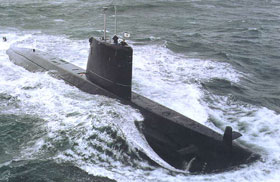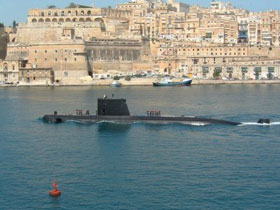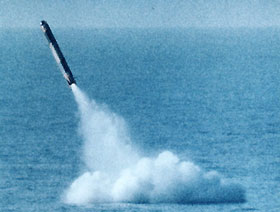 PARIS - The Pakistan Navy has completed customer acceptance of the Hamza diesel-electric submarine, an Agosta B-class boat equipped with a Mesma air-independent propulsion (AIP) system, French naval company DCNS said Sept. 30. PARIS - The Pakistan Navy has completed customer acceptance of the Hamza diesel-electric submarine, an Agosta B-class boat equipped with a Mesma air-independent propulsion (AIP) system, French naval company DCNS said Sept. 30.
Integration of the Mesma AIP module in the Hamza was a world first, DCNS said in a statement.
"Following intensive sea trials, the customer formally declared that PNS Hamza met its acceptance criteria," DCNS said.
An AIP system generates electricity without a snorkel, thus decreasing risk of detection as snorkeling requires running at the surface.
 DCNS hopes to sell further submarines to Pakistan, a company executive said. The Pakistan Navy is understood to have recommended submarines from HDW of Germany. DCNS hopes to sell further submarines to Pakistan, a company executive said. The Pakistan Navy is understood to have recommended submarines from HDW of Germany.
Pakistan Naval Dockyard, Karachi, built the Hamza submarine under a technology-transfer deal with DCNS. Two more Mesma modules are being built for retrofit on the sister boats PNS Khalid and PNS Saad.
While the specs for the Agosta 90B subs say it is equipped to fire Exocet missiles and torpedoes, at a press briefing following the annual naval exercise Seaspark-2001, Rear Adm. Mohammad Afzal Tahir, the deputy chief of naval staff for operations, announced that the Pakistan navy was considering equipping its submarines with nuclear missiles. He suggested the Agosta 90B submarine, with its air independent propulsion system, can deliver nuclear weapons.
The Pakistan Navy, PN Dockyard, Karachi Shipyard and Engineering Works (KSEW) and DCNS cooperated on the Mesma program.
DCNS has also sold six Scorpene diesel-electric submarines with MBDA Exocet anti-ship missiles. India will build the Scorpene under license at local yards.
Exocet Missile Summary:
Exocet AM.39 / MM.40
 Exocet missiles started in development in 1967, originally as the ship-launched variant MM 38 which entered service in 1975. The air-launched version, AM 39, was developed later starting in 1974 and entering service with the French Navy in 1979. The missile is designed to attack large warships. A block 2 upgrade programme was carried out from the late 1980s until 1993, and introduced an improved digital active radar seeker and upgraded inertial navigation and control electronics. Exocet missiles started in development in 1967, originally as the ship-launched variant MM 38 which entered service in 1975. The air-launched version, AM 39, was developed later starting in 1974 and entering service with the French Navy in 1979. The missile is designed to attack large warships. A block 2 upgrade programme was carried out from the late 1980s until 1993, and introduced an improved digital active radar seeker and upgraded inertial navigation and control electronics.
The Exocet has four clipped delta wings at mid-body and four raked clipped-tip moving delta control fins at the rear. The missile is 4.7 m long, has a body diameter of 350 mm and a wingspan of 1.1 m. The missile weighs 670 kg and has a 165 kg HE shaped charge fragmentation warhead. Guidance in the mid-course phase is inertial, followed by an active radar terminal phase. There is also a radar altimeter to control the sea-skimming trajectory, at around 10.0 m until the terminal phase when, in calm sea conditions, the missile can descend to 3.0 m or so. The solid propellant motor gives Exocet a range of about 50 km, but when released from 10,000 m (32,800 ft) the range achieved was reported to be 70 km.
See related story: Could al-Qaeda Take Over Pakistan?
|